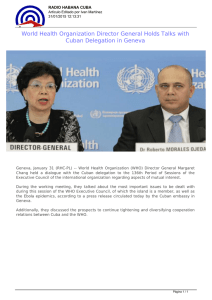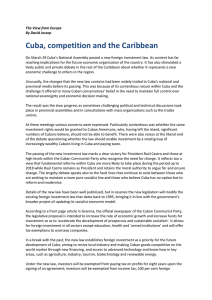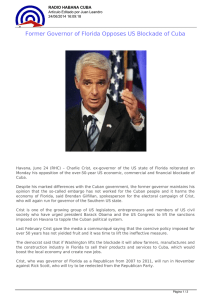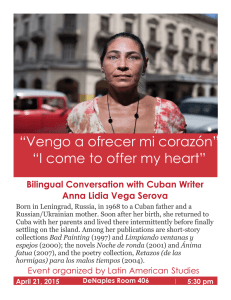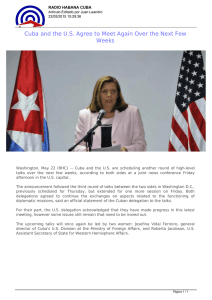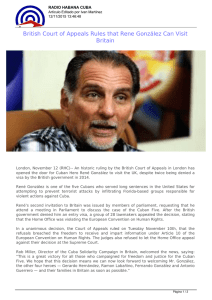The Cuban and Other Revolutions
Anuncio
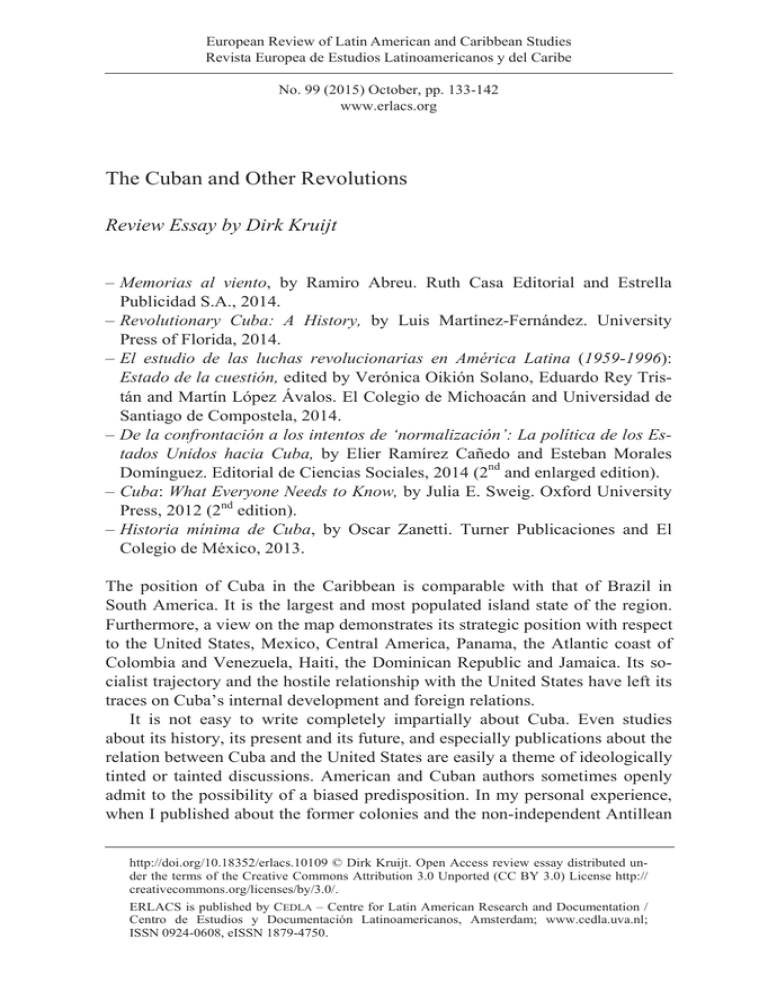
European Review of Latin American and Caribbean Studies Revista Europea de Estudios Latinoamericanos y del Caribe No. 99 (2015) October, pp. 133-142 www.erlacs.org The Cuban and Other Revolutions Review Essay by Dirk Kruijt – Memorias al viento, by Ramiro Abreu. Ruth Casa Editorial and Estrella Publicidad S.A., 2014. – Revolutionary Cuba: A History, by Luis Martínez-Fernández. University Press of Florida, 2014. – El estudio de las luchas revolucionarias en América Latina (1959-1996): Estado de la cuestión, edited by Verónica Oikión Solano, Eduardo Rey Tristán and Martín López Ávalos. El Colegio de Michoacán and Universidad de Santiago de Compostela, 2014. – De la confrontación a los intentos de ‘normalización’: La política de los Estados Unidos hacia Cuba, by Elier Ramírez Cañedo and Esteban Morales Domínguez. Editorial de Ciencias Sociales, 2014 (2nd and enlarged edition). – Cuba: What Everyone Needs to Know, by Julia E. Sweig. Oxford University Press, 2012 (2nd edition). – Historia mínima de Cuba, by Oscar Zanetti. Turner Publicaciones and El Colegio de México, 2013. The position of Cuba in the Caribbean is comparable with that of Brazil in South America. It is the largest and most populated island state of the region. Furthermore, a view on the map demonstrates its strategic position with respect to the United States, Mexico, Central America, Panama, the Atlantic coast of Colombia and Venezuela, Haiti, the Dominican Republic and Jamaica. Its socialist trajectory and the hostile relationship with the United States have left its traces on Cuba’s internal development and foreign relations. It is not easy to write completely impartially about Cuba. Even studies about its history, its present and its future, and especially publications about the relation between Cuba and the United States are easily a theme of ideologically tinted or tainted discussions. American and Cuban authors sometimes openly admit to the possibility of a biased predisposition. In my personal experience, when I published about the former colonies and the non-independent Antillean http://doi.org/10.18352/erlacs.10109 © Dirk Kruijt. Open Access review essay distributed under the terms of the Creative Commons Attribution 3.0 Unported (CC BY 3.0) License http:// creativecommons.org/licenses/by/3.0/. ERLACS is published by CEDLA – Centre for Latin American Research and Documentation / Centro de Estudios y Documentación Latinoamericanos, Amsterdam; www.cedla.uva.nl; ISSN 0924-0608, eISSN 1879-4750. 134 | ERLACS No. 99 (2015) October island of the Kingdom of the Netherlands, I was always cautious to suppress colonial and neo-colonial feelings. Ten years ago, when I co-authored an official report about the uncomfortable and sometimes hostile relations between the Netherlands and its former colony Surinam after its independence, I wished I had been Flemish instead of Dutch. In this review article I present six studies, two by American authors, three by Cuban ones, and one by a Mexican-Spanish editorial team. In several of the reviewed books one can perceive the traces of suppressed uneasiness. Zanetti: Zanetti’s one-volume Historia mínima de Cuba has a remarkably neutral tone. The book is written by a Cuban scholar for a non-Cuban audience (2013, p. 14). Zanetti is a well-known Cuban historian, the head of the Department of History at the Universidad de La Habana for twenty years, and a specialist on the Cuban and Caribbean sugar industry. He published many scholarly studies on this subject and on American-Cuban relations; his second most recent one is a comparative study on the rise and fall of the sugar economy in Cuba, the Dominican Republic and Puerto Rico (Zanetti, 2012). In his Historia mínima de Cuba, the significance of the sugar economy is also an important element of analysis; this time it is related to the slavery and the immigration of Chinese and Spanish labour in the post-slavery period. The book has a chronological sequence with chapters on the native population, the Spanish conquest, the colonial society, the plantation economy, the Spanish colonial status in the nineteenth century, the liberation wars and the American intervention, the independence under American guardianship, the dictatorships and revolutionary efforts before the mid-1950s, the insurgency years (1952-1958), the reforms and reconstruction of economy and society in the 1960s, and the socialist experience up to the succession of Fidel by Raúl Castro in 2006. The most interesting part of the colonial history described by Zanetti is the evolution and consolidation of a plantation economy based on slavery, as the aboriginal society had already been massacred during the first decades of colonial rule. The sugar economy became the principal characteristic of Cuba until the last decades of the twentieth century. It is, on the other hand, astonishing to read how undeveloped Cuba’s sugar economy was under Spanish rule in the eighteenth century, in comparison with the booming sugar estates in the French colony of Saint-Domingue (Haiti), British dominated Jamaica, and even the small Dutch Antillean islands. Only in the early nineteenth century did Cuba’s sugar economy seriously expand. The fate and the preferences of the colonial criollo elite is another remarkable issue. Cuba remained a Spanish colony with the explicit consent of its economic and political elite. The rich plantation owners opted for colonial rule, thought seriously about the convenience of annexation by the United States, and were focussed on the maintenance of the slave system. Although Zanetti does not use the term, nineteenth century Cuban elite is a classic example of a Lumpenbourgoisie in the terms of André Gunter Frank. Dirk Kruijt: The Cuban and Other Revolutions | 135 Cuban historians are inclined to emphasize the violence, corruption, dictatorship, racism and poverty in the years under American tutelage, before the Cuban Revolution. But Zanetti also reports on the relative welfare of the growing Cuban middle classes in the early 1950s: ‘In comparison with the majority of Latin American countries, the standard of living of the Cuban people was quite high. The island occupied the third place – after Argentina and Uruguay – with respect to the daily calories intake per capita, the fourth place regarding the percentage of illiteracy; it also had a relatively low mortality rate’ (p. 250). In 1955, Cuba even had more TVs per capita than France. The two last chapters on the revolution and afterwards are sober and lack the triumphant tone that one can perceive in the publications of other Cuban authors. Zanetti comments on the beneficiaries of the Cuban Revolution, but also mentions the waves of outmigration, and the economic difficulties after the disappearance of generous Soviet economic support. The book ends with the first economic reforms of Raúl in a cautious last sentence: ‘The nature and scope of the changes introduced are still unknown that only time and the Cubans themselves can settle’, (p. 334). Martínez-Fernandez: A recent analysis of the transformations in Cuba’s economy, society and political system is the book of Martínez-Fernández, Revolutionary Cuba: A History. Martínez-Fernandez, a Cuban born professor at the University of Central Florida, does ‘not claim to be free from bias’ (p. 12). With this advertisement in mind, one does not become too irritated after reading ‘“Bad cops” Guevara and Raúl Castro are the radicals who pave the way to communism. Guevara was the consummate “man on horseback”’, (p. 95). Fidel Castro is the ‘master triangulator’ who ‘cunningly applied divisive strategies to purge the military, the cabinet, labour unions, the media, the Church, political parties and other institutions’, p. 56. The triangulation theme will reappear throughout the book. Following the creation of the Communist Party in 1965, Cuba apparently followed a ‘Sino-Guevarist programme’ in 1968 even though ‘Guevara supporters were (…) absent from the party hierarchy’. After Guevara’s death in 1967, the government ‘nationalized all remaining private business and virtually ended all forms of private employment’ (p. 105). Most of the bibliography is based on American sources and the undertone is anti-Castro, although never blatant. The author did not perform primary research (with the exception of several visiting field trips in Cuba) and relies nearly completely on the extensive list of secondary sources mentioned in the bibliography. Part I of the book covers the period up to 1970. Part II reports on the period between 1971 and 1990, analysing it as that of the Soviet dominance. Its emphasis is not unlike the arguments exposed in the well-known study by Richard Gott (2004), which is much more sympathetic to the Cuban regime. Martínez-Fernández (p. 136) makes an interesting observation about the Soviet influence in Cuba: ‘It is curious that despite a substantial and prolonged Soviet and East European presence in Cuba and the tens of thousands 136 | ERLACS No. 99 (2015) October Cubans who spent time studying in the various countries of the socialist block, such nations had a barely perceivable impact on the Cuban people. One interesting exception was the 1970s fad of giving Cuban children Russian names’. The most interesting section of the book is part III, ‘Survival’, the analysis of the period 1991-2013. Here this study provides an overview of the ‘Special Period’ of rationing and hardship in a Spartan economy and society, but again, largely based on American primary sources (pp. 183-189). The period formally lasted several years with the mid-1990s as the peak episode, but one can seriously argue that Cuba is still suffering from its after-effects up to today. Here the text is much more exhaustive than, for instance, another general textbook on Cuba like that of Henken (2008). Martínez-Fernández sketches the economic reforms of the period: foreign investment in the nickel exploitation and in the tourist industry, the legislation on self-employment, the quasi-dollarization of part of the domestic economy by the conversion of (legalized) remittance, with the complicating result of a double currency and in fact parallel economies, this all under an American policy of a tightened trade embargo. Cuba improved their bilateral and multilateral relations with the Caribbean and Latin American region, even under the ‘Lingering Little Cold War’ under the administration of Bush Jr. (pp. 238-241). He also mentions the relative improvement of the Cuban domestic economy after the ALBA agreement between Cuba and Venezuela in 2004. The last twenty pages of the book cover the economic reforms under Raúl Castro after 2006 until the death of Chávez in 2013. The three last pages refer to the significance of Cuban dissident blogger Yoani Sánchez. Sweig: Maybe the best way for students who want to familiarize themselves with Cuba after its Revolution is to read the book of Martínez-Fernandez and that of Sweig simultaneously. Sweig (2002), an eminent scholar who previousO\ SXEOLVKHG D VHPLQDO ERRN RQ WKH &XEDQ LQVXUJHQW XUEDQ XQGHUJURXQG LV according to virulent anti-Castroists VXSSRVHG to have ‘a long history of warm relations with the most extreme elements of the Castro regime’ and to be ‘a foreign agent of influence’.1 Her Cuba: What Everyone Needs to Know was already published in 2009 but has in its second edition an introductory update up to 2012. The book is written in a question-and-answer style in four parts: Cuba before 1959, the Cuban Revolution and the Cold War, 1959-91, the Cuban Revolution after the Cold War, 1991-2006, and After Fidel, under Raúl. Each of the three last parts has the same subdivision: Domestic, U.S.-Cuba, and Cuba in the World. Her book is easy reading, due to her no-nonsense style. To give an idea of the subjects she covers in the 135 issues formulated as a question, I give here the first eleven topics of the ‘domestic’ list for the period 1991-2006: How did the collapse of the Berlin Wall and the dissolution of the Soviet Block affect Cuba? How did Cuba adapt at home to the loss of Soviet subsidies and global realignment brought by the Cold War’s end? Why didn’t the regime collapse? Dirk Kruijt: The Cuban and Other Revolutions | 137 What were the regime’s economic reforms, and why were they so limited? What kind of foreign investments began in Cuba, what consequences did this investment bring to the island, and how did authorities respond? Did Cuba attempt to emulate other economic models during this period? How did artists manage to pull off such a cultural boom in the 1990s? What caused the 1994 balsero refugee crisis? How did the Cuban health care system fare in this period? How did Cuba cope with HIV/AIDS? How did human rights fare more generally during this period? The book’s time scale and analytical content parallels that of MartínezFernandez. It is more sympathetic to the government periods of both Fidel and Raúl, but it is also critical. About the human rights situation in the period 19912006 she writes: ‘Those looking for the end of the Cold War to transform Cuba into a western liberal democracy were sorely disappointed. Organized opposition parties and groups remained proscribed, free speech and assembly continued to be repressed, and, although their numbers had vastly diminished, political prisoners still languished in Cuban jails (…). Of course, repression and intimidation alone are not what keep dissident movements on the island weak and disorganized today (…). Despite profound popular disillusions, the Cuban Revolution does retain domestic sources of legitimacy that limit the extent to which dissident activists might gain foothold (pp. 147, 149). It is interesting to compare the viewpoints of Martínez-Fernandez with those of Sweig on another controversial issue, the so-called Ochoa affair. General Ochoa was one of the most prestigious war heroes of Cuba with a splendid military record during the insurgency against dictator Batista, in the Venezuelan guerrilla, as a commander in the Congo, in Angola and Ethiopia, and a venerated advisor to the Nicaraguan army in the war against the Contramercenaries. Being the commander of Cuba’s Western Army he was detained, condemned in a radio-transmitted court-martial, and executed in 1989. Other army generals and even the then Minister of the Interior were also implicated. He was accused of and sentenced for large-scale corruption, ivory and diamond smuggling, and drug trafficking. Afterwards, the entire Ministry of the Interior was restructured and headed by a close and trusted friend of the Castro brothers, another war hero, Colomé Ibarra. According to Martínez-Fernandez ‘the 1989 purge included scores of individuals, the vast majority of them highranking MININT officials (…). The Castros also purged the Western Army of officers even remotely suspected of pro-Ochoa sympathies. The firings, arrests, trials, prison sentences, and executions had more to do with politics than with crime’ (pp. 176-177). Sweig remarks soberly: ‘Speculation soared that Ochoa’s arrest and execution were a smoke screen to squash a charismatic officer’s attempt to build an independent power base within the Armed Forces and possibly beyond. Yet by all accounts, the trial, which was broadcasted live and transcribed into public proceedings, established a detailed history of illicit activities countenanced by Ochoa and the others. Of course, those convinced that the 138 | ERLACS No. 99 (2015) October whole episode was nothing more than a political show trial would be never be satisfied with such explanation’ (p. 74). Ramírez Cañedo and Morales Domínguez: Cuba’s relation with the United States is a continuous theme of analysis from the early years of the insurgency in the 1950s until the present. After 1959, tensions, open conflicts, covert actions, violence, reciprocal infiltration by intelligence services, a failed invasion on Cuban territory, and unremitting deep mistrust overshadowed the mutual relations. Nevertheless, there is also a history of hidden negotiations, sometimes directly, sometimes through intermediaries. LeoGrande and Kornbluh (2014, reviewed in ERLACS in its April 2015 issue) analysed these back channels in a recent publication, using multiple American sources and interviews, also in Cuba. Ramírez Cañedo and Morales Domínguez did the same, using declassified American material and the Cuban sources in Havana’s Ministry of Foreign Affairs (MINREX) and its think tank ISRI, the Instituto Superior de Relaciones Internacionales. They also interviewed the most direct policy makers at the Cuban Council of State, the Council of Ministers, and the Departamento América (see below). They discussed with Kornbluh and LeoGrande by email. The Cuban senior author, Morales Domínguez, had previously been the co-author of a critical analysis of United States – Cuba relations, published in English (Morales Domínguez and Prevost, 2008), covering the period up to the mid-2000s. The studies are counterpart investigations of fifty years of diplomatic efforts to ‘normalize’ their relations. LeoGrande and Kornbluh are more detailed in their information, but Ramírez Cañedo and Morales Domínguez report about the same events and government periods with more reliance on Cuban sources. The authors of the two books do not basically disagree in their interpretation. The reader of the Cuban examination will perceive an aggrieved intonation, not entirely incomprehensible, comparing the differences in political power and military muscle: Goliath against David. The last chapter of the Cuban authors refers to the government period of Obama. They perceive that Obama in 2013 ‘cut the Gordian knot’ (p. 396). ‘Never before there has been such a broad consensus to change the American policy vis-à-vis Cuba’, they conclude in mid2014, the moment the book was presented to the editorial house (p. 403). The final pages of the book express optimism about improvement of relations. That was a couple of months before 17 December 2014, in fact the moment that the Cold War ended in Cuba. Abreu: One of the perpetual controversies of Cuba’s foreign policy with respect to Latin America, both with respect to the United States and to the Soviet Union, was the support of revolutionary movements in the region. The subsequent prior and successor institutions of the Cuban Departamento América maintained and cultivated the liaisons with radical and guerrilla movements in Latin America and the Caribbean. Until his retirement in 1992, this service was Dirk Kruijt: The Cuban and Other Revolutions | 139 supervised by Manuel Piñeiro, a close friend and confident of Fidel Castro and Che Guevara. The Departamento América functioned as the eyes and ears of the Comandante-en-Jefe. It was always reputed to have phenomenal knowledge of the Latin American Left. One of the principal functionaries was Ramiro Abreu, who was in charge of the relations with Central America for more than thirty years. After his retirement he published his memoirs, Memorias al viento (2013). Abreu is one of the many Cubans whose life was completely altered after the 1959 revolution. Born in a small and extremely poor rural village, he learned to read under the guidance of an old schoolmistress who also told him about the patriotic heroes of the Cuban wars of independence. But even after moving to Havana, ‘my family remained as ignorant and depoliticized as in our rural village’ (p. 51). Ten years old, he had a job selling house-to-house to maintain his mother and sisters. After January 1959 the speeches of Fidel and the revolutionary reforms attracted him to the revolutionary movement. As many others, he completed his university studies serving as a militia member. He fought at the Bay of Pigs and later in Angola. A keen student (he studied sociology and holds a PhD in history) he was selected for a diplomatic posting in Chile and subsequently Mexico. In 1976 he was hand-picked by Piñeiro to become a functionary of the recently created Departamento América. Abreu would attend to Central America until his retirement and still is a member of the Central Committee. One of his first meetings in his new job was with Daniel Ortega and Eden Pastora, then the leading Sandinista comandantes. Until 1979 he was a team member on Nicaragua and he remembers that Fidel Castro visited the department every day, and sometimes several times a day. Immediately after the Sandinista victory he was sent by Castro to Managua to congratulate the young revolutionaries. A week thereafter the new nine Nicaraguan comandantes de la revolución were welcomed in Cuba. For the next thirty years Abreu would travel continuously between Cuba and Central America, especially El Salvador, Guatemala and Nicaragua, and report directly to Piñeiro and Castro, always under the instruction to foster unity within the sometimes recalcitrant constituent politico-military organizations. The chapter on Central America is without doubt the most interesting one of the book, not in the last place because of the small portraits of the leaders of the Central American guerrilla, and their affinity to split on ideological issues. The diplomatic comments of Fidel Castro are also noteworthy. Castro, for instance, remarked to Cayetano Carpio, the leading Salvadoran guerrilla leader who was discussing about revolutionary orthodoxy that ‘if we in the Sierra Maestra would have dedicated ten per cent of what you are discussing about, we would still be sitting high in the mountains’ (p. 194). Another amazing initiative was that Abreu offered a starving ex-major D’Aubuisson (in 1992), founder of ARENA, medical treatment in Cuba when he was denied proper attention in the United States. D’Aubuisson declined the offer and expressed 140 | ERLACS No. 99 (2015) October his high esteem for the courage of his political enemies (pp. 226-230). He confirms Cuba’s good offices during the peace negotiations between the Guatemalan the army and the guerrilla, when, at the request of the Guatemalan president and minister of defence, Cuba accommodated the informal reconciliation meetings between the belligerent parties in 1996. Abreu’s description provides new insight in the relations of Cuba with other revolutionary movements in Latin America. Oikión, Rey and López: Comparative empirical studies about the influence of the Cuban Revolution on other insurgent movements in the region are relatively scarce. The first comparative studies are these of Gott (1971), Lamberg (1979) and Perreira (1995). After the superb study by Wickham-Crowley (1992), I do not know of another region-wide comparison. And that is a standard work written more than twenty years ago. The recently published El estudio de las luchas revolucionarias en América Latina (1959-1996). Estado de la cuestión co-authored by a Mexican-Spanish editorial trio, is a very opportune historiography in eighteen chapters: country chapters on Cuba (two), Argentina, Brazil, Chile, Colombia, El Salvador, Guatemala, Mexico, Nicaragua, Peru, Uruguay and Venezuela. The only other recent edition on the Revolutionary Left in Power is the special issue of Latin American Perspectives, edited by Ellner (2013). The book here reviewed goes deeper, is more complete and, above all, covers a much longer time span. The general notion behind the chapters is the idea that, after the Cuban Revolution, a qualitatively new wave of revolutions emerged, inspired by the Cuban example, which differed both in methods and objectives vis-à-vis the previous nineteenth and twentieth century Latin American revolts and rebellions (p. 9). There are two chapters on Cuba, and the fine analytical chapter about Latin America’s revolutions in comparative and regional perspective written by Rey Tristán is, in my view, the best one of the book. An attractive separate chapter written by Cortina Orero about the smaller revolutionary projects in other countries covers the politico- military movements in Bolivia, Dominican Republic and Paraguay (immediately after and under the influence of Cuban Revolution) and the posterior movements in Costa Rica, Ecuador, Honduras and Panama. A special CD (with 3,000 references, included in the book) offers a quantitative historiographic overview. A general tendency emerging from the chapters is that there is a shift from essays and testimonial publications of the leadership or the veterans in the early years to more analytical and scholarly work in the last two decades. There are, in general, not many comparative studies. Of all Latin American countries, most attention has been paid to Cuba (also in this book), and then to Argentina, Nicaragua and México, in descending order. There is a relatively continuous publication stream in the case of Uruguay, El Salvador, Guatemala and Peru. Also interesting is the fact that, though the guerrilla insurgencies in Brazil, Guatemala and Mexico never comprised a large number of combatants or were Dirk Kruijt: The Cuban and Other Revolutions | 141 a serious threat to national stability, publications about the armed conflict were and are numerous, probably also due to the long-term repression and the astonishing numbers of victims (in Guatemala and Colombia). The book here reviewed, however, does not directly centre on the repression, the presence of military dictatorships or of authoritarian regimes; its principal focus is on the Armed Left. The best chapters have been written by authors who share a background of intense primary source research in the countries of study. Those are the studies about Chile (by Herrera González), El Salvador (one of the best and detailed chapters, co-authored by Álvarez and Sprenkels), Mexico (co-authored by Cedillo and Calderón), Nicaragua (by Oikión) and Uruguay (a detailed analysis by two authors, Rey Tristán and Yaffé). The chapter about Venezuela provides a stimulating overview. Not all the chapters are of the same high quality. The study about Brazil, for instance, is more descriptive than analytical. It covers the entire period of the various and small guerrilla movements, but it only scarcely mentions the vast scholarly publications in English or the large series of monographs issued by the CPDOC, the documentation centre of the Fundação Getulio Vargas in Rio de Janeiro. The study about Peru puts (too) much emphasis on the legacy of Mariategui and his debate with Haya de la Torres in the 1920s, but somehow neglects to analyse the causes and consequences of the first guerrilla waves in the 1960s and the second one of Shining Path. A review of the bibliography of books of Lust (2014, also descriptive but very complete, reviewed in the ERLACS in its October 2014 issue) about the first guerrilla wave and of Degregori (2011) would have improved the text. Also the chapter on Colombia could have been enhanced by incorporating the vary detailed studies (and the abundant bibliography) published by the subsequent Colombian Comisión Nacional de Reparación y Reconciliación and the Centro Nacional de la Memoria Histórica that even during the Uribe government published first-class reports and launched a final report in 2013 (CNMH, 2013). The somewhat critical notes regarding the above are minor. The book as such is excellent and is a must-read research volume for all scholars interested in the Armed Left and the guerrilla movements in Latin America. One might wish that one could form an international team of research fellows with the detailed knowledge of today, starting with a research project to re-study the pioneer analysis of Wickham-Crowley of more than twenty years ago. *** Dirk Kruijt <[email protected]> has been Professor of Development Studies from 1993 to 2008 and is at present professor emeritus at Utrecht University. 142 | ERLACS No. 99 (2015) October Note 1. According to http://dailycaller.com/2013/09/26/nations-most-influential-foreign-policythink-tank-employs-pro-terrorist-castro-follower/, and http://babalublog.com/2013/09/ 27/castroite-links-of-cfrs-julia-sweig-exposed-by-the-daily-caller/, both consulted on 1 May 2015. References CNMH. (2013). ¡Basta Ya! Colombia: Memorias de guerra y dignidad. Informe general. Bogotá: Centro Nacional de la Memoria Histórica. Degregori, C. I. (2011). Qué difícil es ser Dios. El Partido Comunista del Perú – Sendero Luminoso y el conflicto armado interno en el Perú, 1980-1999. Lima: Instituto de Estudios Peruanos. Ellner, S. (Ed.) (2013). Latin America’s Radical left in power: complexities and challenges in the twenty-first century. Issue Edition of Latin American Perspectives 40(3), May. http://dx.doi.org/10.1177/0094582X13478398 Gott, R. (1971). Guerrilla movements in Latin America. Garden City: Doubleday and Company, Inc. Gott, R. (2004). Cuba. a new history. New Haven: Yale University Press. Henken, T. A. (2008). Cuba. A global studies handbook. Santa Barbara: ABC-CLIO Inc. Lamberg, R. (1979). La guerrilla en América Latina. Madrid: Editorial Mediterráneo. LeoGrande, W. M., & Kornbluh, P. (2014). Back channel to Cuba: The hidden history of negotiations between Washington and Havana. Chapel Hill: The University of North Carolina Press. http://dx.doi.org/10.5149/northcarolina/9781469617633.001.0001 Lust, J. (2013). Lucha revolucionaria. Perú, 1958-1967. Barcelona: RBA Libros. Morales Domínguez, E., & Prevost G. (2008). United States Cuban relations: a critical history. Lanham: Lexington Books, 2008. Pereira, D. (1995). Del Moncada a Chiapas. Historia de la lucha armada en América Latina. Madrid: Los Libros de la Catarata (second edition). Sweig, J. (2002). Inside the revolution. Fidel Castro and the urban underground. Cambridge, MA: Harvard University Press. Zanetti Lecuona, O. (2012). Esplendor y decadencia del azúcar en las Antillas Hispanas. Havana: Editorial de Ciencias Sociales and Ruth Casa Editorial.
